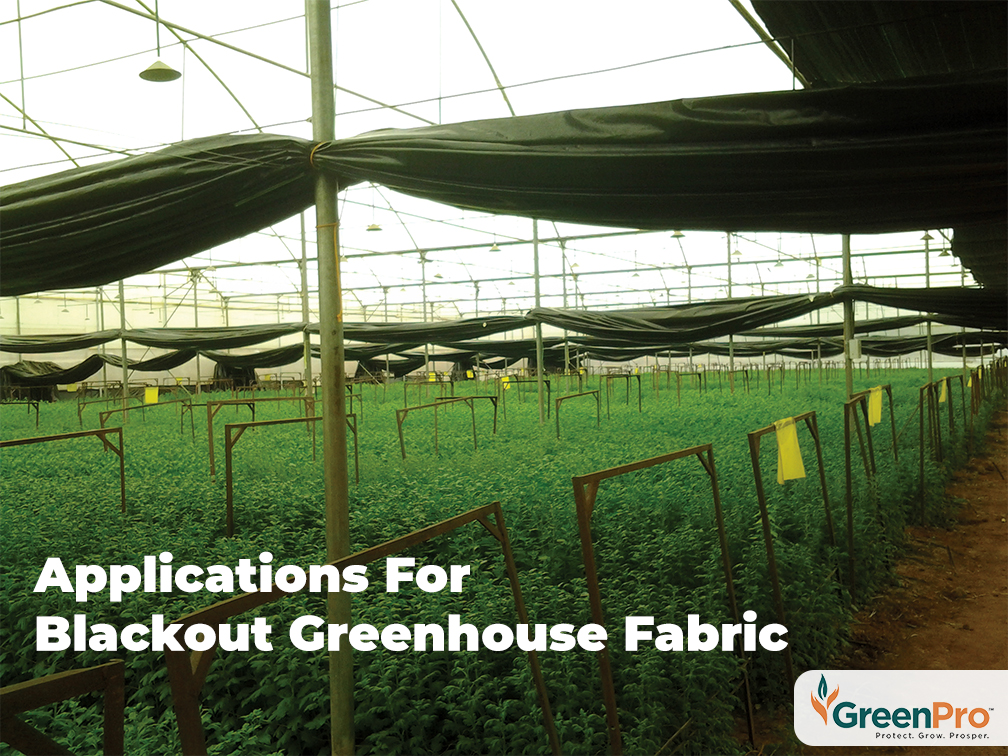Applications For Blackout Greenhouse Fabric

Greenhouse goes back right to Roman Empire when Emperor Tiberius requested to eat an Armenian cucumber consistently, for which his landscapers needed to utilize a framework similar to that in modern greenhouses to make sure he had one each day. However, 13th-century Italy was the site of the first modern greenhouses. A greenhouse is simply a structure in which plants are grown, which functions based on a physical concept of the rate at which thermal energy flows out of its structure, and it does this by impeding heat that has been absorbed from leaving its confines through convection. The material for greenhouse construction is typically glass or plastic so that sunlight can pass through it. This sunlight is integral to the greenhouse becoming warm since it heats up the ground inside the greenhouse. In turn, the warm ground then warms up the air in the greenhouse, which keeps on heating the plants inside since it is confined within the structure of the greenhouse.
However, in spite of the concept and functioning of the greenhouse is so simple and has been carried on for centuries there are times when many different challenges that disrupt the regular approach to the greenhouse. One such major challenge is carrying the plantation of sensitive plants within a regular greenhouse. It is because sensitive plants are those that readily react to sunlight, which eventually results in drying out or dying out of the plant with end result of reflecting very poor yield or quality of yield delivered is unusable. It is because of this problem it was extremely important to draw a solution that would help plantation of sensitive plants within the greenhouse without having to worry about the plant or its yield.
The resolution to this challenge was first discovered and applied in 1594 in Greece and was termed the blackout greenhouse, where the primary function looks to keep the plant in shade within the greenhouse. In order to create a blackout greenhouse in today’s world usage of the right fabric to create the dark effect on the greenhouse is extremely important.
Let’s take a look at what a blackout greenhouse is and how a fabric can create a blackout effect in the greenhouse.
What is Blackout Greenhouse?
A blackout greenhouse is a structure in which the covering of the structure rather than left out transparent is covered with a film of fabric that is usually of dark color. This results in creating a translucent or complete darkness effect within the structure of the greenhouse. The translucent or dark effect of a blackout greenhouse thoroughly depends on the type of fabric used for the purpose of creating a blackout greenhouse. These shade or dark greenhouses are specialized structures developed using a blackout fabric for the purpose of planting sensitive plants, highest quality flowers, much better yield, and multiple harvests in a single year without being dependent on the season to grow a particular fruit, flower, or plant. This in turn helps growers to have a head-on advantage and control on their plantation. But the requirement of the blackout greenhouse and the effect it creates thoroughly depends on the plantation that is being bred within the greenhouse. It is because of this reason it is of prime importance to select the right fabric for the blackout greenhouse.
The Fabric Required for Blackout Greenhouse
The fabrics used for the purpose of developing a blackout greenhouse are of four different variants. They are Bold – 100% light blockage material, Breathable – 90% light blockage material, Woven – 80% light blockage material, and lastly the Panda – 70% light blockage material. It is thoroughly based on the requirement of the greenhouse and plantation aims to be produced within the greenhouse growers can actually select from these 4 variants of blackout fabric to create their own greenhouse.
Detailed Defining of Each Fabric Material used for Blackout Greenhouse
- Bold: These are fabrics made from a mix of virgin polyethylene resins and polyester with an average thickness of 9.0 millimeters of the fabric.
- Breathable: These are fabrics made from 3-5 layers of horticulture-grade textiles with an average thickness of 8.0 millimeters of the fabric.
- Woven: These are fabrics made from lightweight interwoven poly strips with an average thickness of 7.0 millimeters of the fabric.
- Panda: These are fabrics made from lightweight Polyethylene with an average thickness of 6.5 millimeters of the fabric.
The material used in the development of each type of fabric clearly reflects the impact that each of the fabric can have in the case of a blackout greenhouse, with Bold reflecting complete darkness and Panda reflecting a translucent environment. While on the other hand Breathable and woven, clearly reflects a moderate environment between translucent and total darkness phase.
Characteristic of Blackout Fabric
Some of the major characteristics of blackout fabrics that make them stand out from other possible greenhouse fabrics are reflected below:
- Greenhouse Blackout Fabrics are much tougher than any plastic sheet or film, allowing for many years of continuous use
- The outer layer of blackout fabric has a white layer that is enhanced with UV inhibitors and designed to reduce heat build-up and condensation
- Blackout greenhouse fabric provides complete control to growers on ultraviolet ray control reflecting a thorough UV stabilization with the usage of blackout fabric
- Blackout greenhouse fabric contains polyethylene component as their manufacturing basic material, because of this reason, the fabric is waterproof in nature
- Manufactured from a mix of virgin polyethylene resins and polyester with an average thickness of 9.0-millimeter blackout greenhouse fabric are tear-resistant in nature and has the ability to absorb high impact because of their basic tensile strength contributed by the molecular structure developed during the manufacturing of the fabric
- Blackout fabrics are available in black on a white combination that allows reflection of the extra heat from the outside from entering the greenhouse
- Blackout fabric comes with both heat reflective and retention capability
- The blackout fabric is the ideal material for the development of an automated blackout system in a greenhouse
These characteristics ensure the development of a proper blackout greenhouse for growers helping them achieve their target vision.
Specification of Blackout Fabric for Greenhouse
The variant availability of blackout fabric comes with the following specifications that are ideal for all types of blackout greenhouses:
- The fabric is available in bipolar color black on white
- The fabric is available in wide width size making it ideal for all types of greenhouses
- The fabric can be welded to increase the size as per the requirement of the grower
- The usual thickness of the fabric varies between 6.5 millimeters and 9 millimeters.
These specifications offered by Greenpro’s blackout fabric make it an ideal selection for all those who are interested in creating a blackout greenhouse for their plantation purpose.
If you are into creating your own greenhouse and looking for the development of a light deprivation greenhouse that is suitable for sensitive plants requiring photoperiod control, such as Medical plants, or seeding, vegetables, flowers, don’t look any further. Come to us at Greenpro where we offer blackout fabric for total light deprivation uses, which is would be the ideal material to create your dream blackout greenhouse.
Why Choose Us
At Greenpro our blackout fabrics are designed to prevent needle holes from passing light, giving you absolute control over lighting. With over decades of experience in the field of fabric development for agricultural and greenhouse purposes, at Greenpro we hold all the latest technology that can provide you with the best quality of fabric for your blackout greenhouse. Our fabric development processes are thoroughly quality controlled under ISO making sure that every product that we produce defines premium quality. Each and every one of our fabrics that are produced thoroughly undergoes a rigorous testing process making sure that the fabric can withstand the torment of natural elements like sunlight, high temperature, rainfall, wind, and more. This allows us to deliver blackout fabrics that are unparallel in the market for greenhouse usage. If you are looking for the perfect, quality fabric at a competitive price for your blackout greenhouse please contact us at Greenpro, we would be very happy to help you.
